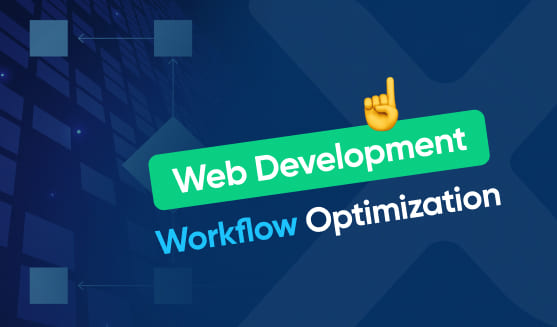
In today’s fast-paced digital world, efficient web development workflow optimization has become crucial for businesses seeking a competitive edge. By understanding the components, strategies, and techniques involved in optimizing web development workflow, organizations can streamline their processes, maximize efficiency, and deliver high-quality products to their clients.
Understanding Web Development Workflow
Web development workflow refers to the systematic approach that developers follow in creating websites or web applications. It encompasses all the steps from the initial planning and design phase to development, testing, and deployment. An efficient workflow ensures that the project progresses smoothly, minimizing errors, redundancies, and delays.
Importance of an Efficient Web Development Workflow
An efficient web development workflow offers numerous benefits. Firstly, it improves productivity by reducing time wasted on unnecessary tasks or inefficient processes. It also enhances collaboration among team members, allowing for seamless communication and better coordination. Moreover, an optimized workflow promotes quality assurance and helps to avoid costly mistakes or bugs that can negatively impact the end-user experience.
Key Components of a Web Development Workflow
A web development workflow consists of several essential components. These include:
- Project Planning: Defining project objectives, scope, and requirements.
- Design: Creating wireframes and visual mockups to outline the website’s structure and aesthetics.
- Development: Writing code and implementing functionality using appropriate programming languages and frameworks.
- Testing: Conducting thorough QA testing to identify and fix any bugs or issues.
- Deployment: Launching the website on a live server for public access.
- Maintenance: Regularly updating and optimizing the website to ensure its smooth operation.
Each of these components plays a crucial role in the overall web development workflow. Let’s delve deeper into each one:
Project Planning: This initial phase sets the foundation for the entire project. It involves defining the project’s objectives, scope, and requirements. Project planning helps establish clear goals and expectations, ensuring that the development team and stakeholders are on the same page. It also includes conducting market research and competitor analysis to identify opportunities and create a strategic plan.
Design: Once the project’s goals and requirements are defined, the design phase begins. Designers create wireframes and visual mockups to outline the website’s structure, layout, and aesthetics. This step allows stakeholders and the development team to visualize the final product and make necessary adjustments before proceeding to the development stage. Designers also consider user experience (UX) principles, ensuring that the website is intuitive, visually appealing, and easy to navigate.
Development: In the development phase, developers bring the design to life by writing code and implementing functionality. They use appropriate programming languages and frameworks to build the website’s front-end and back-end components. This stage requires attention to detail and adherence to coding best practices to ensure a clean, efficient, and maintainable codebase. Collaboration between designers and developers is crucial during this phase to ensure that the final product matches the intended design and functionality.
Testing: Once the development is complete, thorough QA testing is conducted to identify and fix any bugs or issues. This step ensures that the website functions as intended and provides a seamless user experience. Testing involves various techniques, such as functional testing, performance testing, and cross-browser compatibility testing. By addressing any issues before deployment, the development team can deliver a high-quality website that meets the project’s requirements.
Deployment: After successful testing, the website is ready for deployment. This involves launching the website on a live server, making it accessible to the public. The deployment process requires careful planning and coordination to ensure a smooth transition from the development environment to the live environment. It may involve tasks such as configuring servers, setting up databases, and optimizing performance to handle anticipated traffic.
Maintenance: Once the website is live, regular maintenance is essential to ensure its smooth operation. This includes monitoring performance, updating software and plugins, and addressing any security vulnerabilities. Maintenance also involves analyzing user feedback and data to identify areas for improvement and implementing updates accordingly. By proactively maintaining the website, developers can provide a positive user experience and keep the website up-to-date with evolving technologies and user expectations.
By following a well-defined web development workflow and paying attention to each component, developers can create high-quality websites that meet client expectations and provide an exceptional user experience.
Strategies for Workflow Optimization
To optimize web development workflow, organizations should adopt effective strategies that enhance efficiency and productivity. Two key strategies include streamlining the development process and utilizing the right tools and technologies.
Efficient workflow optimization is crucial for web development projects to ensure timely delivery and high-quality outcomes. By implementing strategic approaches, organizations can streamline their processes and maximize productivity, ultimately leading to successful project completion.
Streamlining the Development Process
One way to optimize workflow is by streamlining the development process. This involves breaking down the project into smaller, manageable tasks and assigning them to team members based on their expertise and availability. By dividing the workload, developers can work concurrently, reducing project timelines and maximizing efficiency. Additionally, using agile methodologies such as Scrum or Kanban can help prioritize tasks, optimize collaboration, and ensure timely project delivery.
Effective communication and collaboration among team members are essential components of streamlining the development process. Regular stand-up meetings, progress updates, and feedback sessions can help keep the team aligned and focused on project goals. By fostering a collaborative environment, organizations can enhance teamwork and boost overall productivity.
Utilizing the Right Tools and Technologies
The proper use of tools and technologies can significantly impact web development workflow optimization. Employing integrated development environments (IDEs) like Visual Studio Code or JetBrains WebStorm can enhance coding capabilities and streamline the coding process. Version control systems like Git enable seamless collaboration and efficient code management. Additionally, project management tools such as Jira or Trello facilitate task tracking, progress monitoring, and effective communication among team members.
Continuous evaluation and adoption of new tools and technologies are essential for staying ahead in the rapidly evolving web development landscape. By staying informed about the latest industry trends and advancements, organizations can leverage cutting-edge solutions to further optimize their workflow and drive innovation.
Workflow Optimization Techniques
In addition to overall strategies, specific techniques can be applied to optimize web development workflow further.
Prioritizing Tasks for Maximum Efficiency
Prioritizing tasks is crucial for optimizing workflow efficiency. By adopting an Agile or Kanban approach and creating a prioritized backlog, developers can focus on the most critical tasks first and ensure timely completion. Regularly reassessing priorities throughout the project ensures that efforts align with changing business requirements and that the most valuable features are developed first.
Automation in Web Development Workflow
Automation plays a vital role in optimizing web development workflow. By automating repetitive tasks such as code linting, code formatting, or deployment processes, developers can save valuable time and reduce the chances of human error. Tools like Gulp or Grunt can automate common development tasks, while continuous integration and deployment (CI/CD) pipelines simplify the release process, ensuring frequent and reliable software updates.
Challenges in Workflow Optimization
While workflow optimization is critical for success, organizations may face various challenges along the way.
Common Obstacles in Optimizing Workflow
Some common obstacles include resistance to change, lack of standardized processes, and inadequate communication among team members. Resistance to change can hinder the adoption of new tools or methodologies, delaying workflow optimization initiatives. Moreover, the absence of standardized processes can cause confusion and inconsistencies among team members, reducing overall efficiency. Inadequate communication can lead to misunderstandings, delays, and an overall lack of synergy in the workflow.
Overcoming Challenges in Workflow Optimization
To overcome these challenges and optimize workflow effectively, organizations should prioritize clear communication, provide comprehensive training and support during the transition, and foster a culture of continuous improvement and innovation. Embracing change, implementing best practices, and leveraging feedback can help overcome resistance and make workflow optimization a collaborative effort.
Measuring the Success of Workflow Optimization
Measuring the success of workflow optimization is essential to determine its effectiveness and identify areas for further improvement.
Key Performance Indicators for Workflow Optimization
Key performance indicators (KPIs) can provide valuable insights into workflow optimization. Some relevant KPIs include:
- Development Time: Measuring the time it takes to complete development tasks and deliver a working product. A decrease in development time indicates improved workflow efficiency.
- Bug Density: Calculating the number of bugs or issues per lines of code. A decrease in bug density signifies improved code quality and efficient testing processes.
- Customer Satisfaction: Gathering feedback from clients or end-users to measure their satisfaction with the final product. The higher the satisfaction rate, the more successful the workflow optimization.
Continuous Improvement in Web Development Workflow
Workflow optimization is an ongoing process. By regularly evaluating the effectiveness of the workflow, seeking feedback from team members and stakeholders, and leveraging emerging technologies and industry best practices, organizations can continuously improve their web development workflow, ensuring long-term success and delivering exceptional results.
In conclusion, web development workflow optimization is crucial for businesses seeking to maximize efficiency, reduce errors, and deliver high-quality products. By understanding the components, strategies, and techniques involved, organizations can streamline their processes, enhance collaboration, and achieve significant improvements in their web development workflow. Overcoming challenges, measuring success using relevant KPIs, and fostering continuous improvement will ultimately lead to long-term success in web development workflow optimization.
In conclusion, web development workflow optimization is crucial for businesses seeking to maximize efficiency, reduce errors, and deliver high-quality products. By understanding the components, strategies, and techniques involved, organizations can streamline their processes, enhance collaboration, and achieve significant improvements in their web development workflow. Overcoming challenges, measuring success using relevant KPIs, and fostering continuous improvement will ultimately lead to long-term success in web development workflow optimization.


